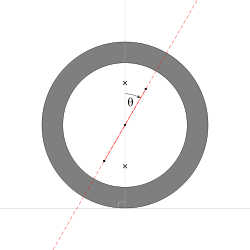Caster angle


The caster angle[1] or castor angle[2] is the angular displacement of the steering axis from the vertical axis of a steered wheel in a car, motorcycle, bicycle or other vehicle, measured in the longitudinal direction. It is the angle between the pivot line (in a car an imaginary line that runs through the center of the upper ball joint to the center of the lower ball joint) and vertical. In automobile racing, the caster angle may be adjusted to optimize handling characteristics for a particular venue.
History
Arthur Krebs proposed placing the front axle of a car at a positive caster angle in his UK patent of 1896, entitled Improvements in mechanically propelled vehicles.. In it he stated it was intended "To ensure stability of direction by means of a special arrangement of fore-carriage, that is to say, to re-establish automatically the parallelism of the two axles of the vehicle when there is no tendency to keep them in any other direction, or after a temporary effort has caused them to diverge from said parallelism. [...] The axle of the fore-carriage is situated a suitable distance behind the projection of the axis of the pivot-pin in order to ensure the stability of direction above referred to."
Positive caster angle
The pivot points of the steering are angled such that a line drawn through them intersects the road surface slightly ahead of the center of the contact patch of the tire on the pavement by a distance called trail. The purpose of this is to provide a degree of self-centering for the steering — the wheel casters around in order to trail behind the axis of steering. This makes a vehicle easier to control and improves its directional stability (reducing its tendency to wander). Excessive caster angle will make the steering heavier and less responsive, although in racing large caster angles are used for improving camber gain in cornering. Caster angles over 7 degrees with radial tires are common. Power steering is usually necessary to overcome the jacking effect from the high caster angle.
Some streetcar front-end alignment calls for different right side and left side caster. This is called cross caster and the difference is called the spread. Cross camber may also be specified, but not usually both.[3]
Trail or trailing
The steering axis (the red dotted line in the diagram above) does not have to pass through the center of the wheel, so the caster can be set independently of the trail, which is the distance between where the steering axis intersects the ground, in side view, and the point directly below the axle. The interaction between caster angle and trail is complex, but roughly speaking they both aid steering: caster tends to add damping, while trail adds 'feel', and returnability. In the extreme case, such as the caster wheel on a shopping cart, the system is undamped but stable, as the wheel oscillates around the 'correct' path. The shopping trolley/cart setup has a great deal of trail, but (somewhat confusingly) no caster. Complicating this still further is that the lateral forces at the tire do not act at the center of the contact patch, but at a distance behind the nominal contact patch. This distance is called the pneumatic trail and varies with speed, load, steer angle, surface, tire type, tire pressure and time. A good starting point for this is 30 mm behind the nominal contact patch.
Front end alignment
When the front suspension of a vehicle is aligned, caster is adjusted to achieve a self-centering action in the steering, which affects the vehicle's straight-line stability. Improper caster settings will require the driver to move the steering wheel both into and out of each turn, making it difficult to maintain a straight line.
Two-wheeled vehicles
In the context of bicycles and motorcycles, caster is more commonly referred to as "head angle", "rake angle" or "rake and trail", especially in American English. The terms caster or castor angle are still predominantly used in British English.
Some bicycle constructors refer to the angle subtended by the mechanical trail at the wheel center as caster.[4]
See also
References
- ↑ "Merriam Webster Dictionary". Retrieved 2009-12-25.
caster n : the slight usually backward tilt from vertical of the axis of the steering mechanism of an automobile for giving directional stability to the front wheels
- ↑ Oxford English Dictionary (2nd ed.). Oxford University Press. 1989.
castor angle, the angle at which the steering-head of the front wheels of a motor vehicle is set
- ↑ Tim Gilles (24 July 2012). Automotive Service: Inspection, Maintenance, Repair. Cengage Learning. pp. 1273–. ISBN 1-133-42068-0.
- ↑ http://www.bikeforest.com/CAD/caster_angle.php